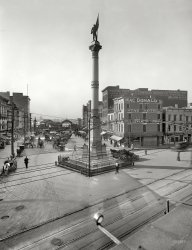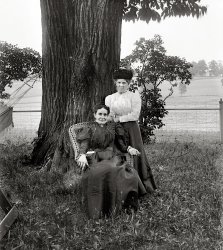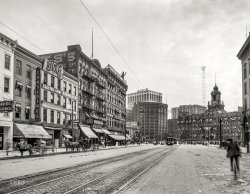
MAY CONTAIN NUTS

Search Shorpy
SHORPY ART

Framed or unframed, desk size to sofa size, printed by us in Arizona and Alabama since 2007. Explore now.
Join and Share
Ad-Free Shorpy
Shorpy is funded by you. Patreon contributors get an ad-free experience.
Learn more.

Recent comments
- Baldwin 62303
- Baldwin VO-1000
- Cold
- No expense spared
- Tough Guys
- Lost in Toyland
- And without gloves
- If I were a blindfolded time traveler
- Smoke Consumer Also Cooks
- Oh that stove!
- Possibly still there?
- What?!?
- $100 Reward
- Freeze Frame
- Texas Flyer wanted
- Just a Year Too Soon
- WWII -- Replacing men with women at the railroad crossing.
- Yes, Icing
- You kids drive me nuts!
- NOT An Easy Job
- I wonder
- Just add window boxes
- Icing Platform?
- Indiana Harbor Belt abides
- Freezing haze
- Corrections (for those who care)
- C&NW at Nelson
- Fallen Flags
- A dangerous job made worse
- Water Stop
Member Photos
The Shorpy
Print Emporium
Print Emporium
Search Shorpy
Search results -- 30 results per page
- Federal Auto: 1917
- ... a good hot 25-cent meal sure hit me between the eyes.
Dairy Lunch I always assumed, when I saw "dairy lunches" mentioned in old ... this is the craziest kosher restaurant ever! So what is a dairy lunch, anyway?
[The "dairy lunch room" came to prominence in the ... Posted by Dave - 08/07/2012 - 10:18pm -
![Federal Auto: 1917 Washington, D.C., circa 1917. "Federal Auto Supply Co., Pennsylvania Avenue." National Photo Company Collection glass negative. View full size.
The legless beggarDid the photographer mean to make a social statement with this picture? Probably not, considering racial attitudes back then. But a legless black beggar one door away from a good hot 25-cent meal sure hit me between the eyes.
Dairy LunchI always assumed, when I saw "dairy lunches" mentioned in old novels, that it meant the same thing in gentile circles that it does in Jewish ones -- that is, a restaurant that doesn't serve meat. Looking at this photo, I'm getting the idea that I might have been wrong about that. Either that or this is the craziest kosher restaurant ever! So what is a dairy lunch, anyway?
[The "dairy lunch room" came to prominence in the late 19th century, offering fast food for white-collar workers. The name signified "not a saloon" as much as it did the contemporary fad for malteds, shakes and ice cream. Dairy bars found new popularity with the rise of the temperance movement and advent of Prohibition. A lot of these places were former taverns. - Dave]
LunchBeen a while since I've had liver and onions for any meal let alone lunch. I'll spring for the small steak for man in need at the drug store. Any idea what the hose near the curb might have been for?
Today's QueryAnyone know where I can get some hot rolls?
InterchangeabilityHm. Ford Parts next door to Ford Lunch -- maybe I don't wanna know.
Eh?477 would be right about where the Canadian Embassy is now.
A Legless VeteranGiven the dating of the picture as "circa 1917" I think it's reasonable to suppose that the legless man might be a World War I veteran injured in the War.
[He's an old man, so he would not be a WWI vet. - Dave]
The Dairy Lunch todayThe Court Street Dairy Lunch still exists in Salem, Oregon. A luncheon based on dairy products must have been considered particularly healthsome.
Re: Eh?Unless it was 477 Penn Ave SE, which would put it behind the capital about halfway to Eastern Market. Some surviving buildings in that neighborhood are reminiscent of these buildings.
[This is 477 Pennsylvania Avenue Northwest. - Dave]
Dairy Lunch ReduxOh, of course! Duh! Thank you! To differentiate themselves from the "free lunch" offered by bars, as a respectable eating place. I suppose the "family lunch" places we've seen advertised in some photos had the same idea.
Tire TrollopThat appears to be the Kelly Girl in the left door. An infamous ad from 1910 showed her sitting on a Kelly tire and exposing her ankles! It was a huge controversy.
(The Gallery, Cars, Trucks, Buses, D.C., Natl Photo)](https://www.shorpy.com/files/images/32857u.thumbnail.jpg)
- Detroiter and Argo: 1915
- ... I guess I've led a sheltered life or something. Seeing "Dairy Lunch" signs in at least a couple Shorpy photos and wasn't sure what it ... know more about this interesting term?
[More on the "dairy lunch" phenomenon here . - Dave]
Thanks Dave. In addition to ... Posted by Dave - 09/04/2012 - 9:38pm -
![Detroiter and Argo: 1915 Washington, D.C., circa 1915. "W.L. Smith agency, Argo cars, 14th Street N.W." Also home, as seen here earlier, to the Square Deal Auto Exchange. National Photo Company Collection glass negative. View full size.
Geyer's Beer Garden
Washington Post, Oct 7, 1909.
Geyer's Palm Garden.
F.H. Geyer has done much for upper Fourteenth street in the way of palm garden amusements for summer evenings. He purchased the place from George F. Kozel, and remodeled it, making it the best equipped in this vicinity. His winter palm garden, which has just opened, is one of the fashionable resorts of the northwest. The catering is excellent, seafood a speciality, and good music is always an attraction.
Washington Post, Oct 22, 1933.
Beer Gardens of Old Capital Added Froth to Life.
…
On Upper Fourteenth street, just below U, was the dandy of all beer gardens — Geyer's. Out in the back yard, covered with gravel that persistently got in low shoes, a band blared away while waiters rushed to and from with seidels, steins, and schooners. Geyer's was the Mecca for young love; for the young blades of the day. It was packed and jammed nightly.
Gentlemen!An early SCCA or IMSA gathering. The stretch of 14th (and 15th) out from Massachusetts Avenue seemed to attract auto sales emporiums. I remember them from when at SJC on Vermont Avenue back before time was invented.
Almost 100 years laterView Larger Map
As Seen on ShorpyMore on the Argo Cyclecar here and here.
A Quick GetawayLooks like the starting lineup of the Annual Al Capone 500.
Holy Cow - another dairy sign!I guess I've led a sheltered life or something. Seeing "Dairy Lunch" signs in at least a couple Shorpy photos and wasn't sure what it meant -- milkshakes? I did a little Internet searching and I see its use being Jewish to separate meat from dairy, more like fish, eggs and dairy products. It is also the part of many restaurant names. Anyone know more about this interesting term?
[More on the "dairy lunch" phenomenon here. - Dave]
Thanks Dave. In addition to the extra Dairy Lunch info you've provided, I also just discovered that I can add another comment below yours ... well, at least I hope so. I will find out if this comment shows up. Love this website!
(The Gallery, Cars, Trucks, Buses, D.C., Natl Photo)](https://www.shorpy.com/files/images/SHORPY_31804u.thumbnail.jpg)
- Our Confederate Dead: 1910
- ... many towns the main streets are so wide.
Note Murray's Dairy Lunch with Coca-Cola "at our fountain" sign. And at least two wholesale ... for a while but I'm double-parked.
Murray's Dairy Lunch Was Murray's the 1910 equivalent of the Kosher, Ratner's Dairy ... Posted by Dave - 08/21/2012 - 5:18pm -

- National Theatre: 1918
- ... to the street. It's like walking into a cocoon.
Dairy Lunch "Dairy Lunch" for a restaurant seems so unpalatable. I am wondering if there is ... Posted by Dave - 08/27/2012 - 3:21pm -
![National Theatre: 1918 March 1918. The National Theatre on E Street. At right is Shoomaker's, a favorite Shorpy hangout. Harris & Ewing glass negative. View full size.
Back to the SpongeDave, I've seen North By Northwest several times but other than the scene in the Plaza Hotel where Kaplan's suit is being delivered to the room or is that what you're referring to.
[Not sure I follow the question. Script below. - Dave]
Cary Grant at the Ambassador East, on phone to valet:
"Room 463. How quickly can you get a suit sponged and pressed? Yes, fast. 20 minutes? Fine."
Sponge Again Part 2Ok, but how did you remember such an insignificant piece of dialogue from a 50 year old movie.
[I've seen the movie and remembered the line is the best explanation I can give! - Dave]
Sponge AgainThanks, you answered my question. My new question is: How did you come up with that answer to a question so obscure, that quickly? You never cease to amaze me.
[I Googled the script for "North by Northwest." - Dave]
Out With The OldDid the "old" National Theatre burn down?
[The National had been "new" for more than 20 years, having been rebuilt following a fire in February 1885. The building in this photo was was torn down in 1923 and replaced with the current structure. This section of E Street is now part of Pennsylvania Avenue. - Dave]
WindowsThe one thing that always strikes me is all the open windows in these old large buildings, even in the winter. Today, working in Downtown anywhere, the windows will almost certainly be sealed shut, a consequence of our new ventilation systems. What we have lost is the connectedness to the street. It's like walking into a cocoon.
Dairy Lunch"Dairy Lunch" for a restaurant seems so unpalatable. I am wondering if there is some other reason to the name? Did it signify that it was non-kosher because dairy was served there? Or was it the other way around--meaning that there was no meat(only fish) served there?
["Milk bars" and "dairy lunches" were a phenomenon of the 1910s, 20s and 30s, a byproduct of the temperance movement. A lot of these places were bars and pubs before Prohibition. - Dave]
Baths?The pole on the sidewalk on the left side of the image appears to say "Baths." Would this be correct?
[Yes, if you needed one. - Dave]
SpongeThe tailor shop, to the left of National Dairy Lunch, has a sign in its window "Suits Sponged and Pressed." I've never seen or heard that term before. Was it an early form of dry cleaning or an expeditious way of getting the garment clean.
[So you've never seen "North by Northwest." - Dave]
Shows at the National"The Land of Joy" was a Spanish musical revue that opened on Broadway on Oct. 31, 1917 and closed in January 1918 after 100 performances. "Friendly Enemies" opened in New York on July 22, 1918, and closed in August 1919 after 440 performances--a major hit for 1918. The posters must be announcing an out-of-town tryout.
[A January 1918 item in the New York Times has "Friendly Enemies" set for a February opening in New York. For reasons unknown, it didn't happen. The play opened in Atlantic City before going to Washington. - Dave]
(The Gallery, D.C., Harris + Ewing, Performing Arts)](https://www.shorpy.com/files/images/13909a_0.thumbnail.jpg)
- Mothproof: 1920
- ...
[Mothproof garment bags. - Dave]
"Cafe and Dairy Lunch" appears to be on the wall behind the Peoples Drug sign. ... Posted by Dave - 12/08/2011 - 9:49am -
![Mothproof: 1920 Washington, D.C., circa 1920. "Peoples Drug Store, 14th & U." A nighttime view of the store seen here and here and here. Your headquarters for "tar bags." National Photo Company Collection glass negative. View full size.
Just WonderingWhat are Tar Bags?
[Mothproof garment bags. - Dave]
"Cafe and Dairy Lunch"appears to be on the wall behind the Peoples Drug sign. Let's hope they moved to a new location and didn't go out of business.
The sidewalk is filthy with cigar butts and other trash. That wasn't unusual in the old days. I remember it being that way when I was a kid. Try throwing a candy bar wrapper or cigar butt on the ground today in front of someone and see what happens.
They don't sell light bulbsEvidently, since I count 25 burned out in the sign.
It's organizedBug killing stuff on the left, people killing stuff on the right.
Broom anyone?You would have thought they would send the stock boy out to at least broom off the front entrance sidewalk before snapping a pic of the store. While he's at it, give him a quart of paint and a brush for the front door.
(The Gallery, D.C., Natl Photo, PDS, Stores & Markets)](https://www.shorpy.com/files/images/28986u.thumbnail.jpg)
- The Storms of Lewinsville: 1910
- ... Its bottling plant was at 3247 Q Street. There were also "dairy lunch rooms" at 2005 Florida Avenue and at Florida and Seventh Street. ... Posted by Dave - 01/23/2010 - 1:57am -

- Peoples Drug No. 3: 1920
- ... thing doesn't work out, we can reopen the cafe and dairy lunch.
Bachelors, Second Floor ... Old Maids on 3. Step to the ... Posted by Dave - 12/08/2011 - 9:46am -
![Peoples Drug No. 3: 1920 Washington, D.C., circa 1920. "People's Drug Store, 14th and U." Your Hypo-Cod headquarters. National Photo Co. Collection glass negative. View full size.
Sign o the timesMaybe if the Hypo-Cod thing doesn't work out, we can reopen the cafe and dairy lunch.
Bachelors, Second Floor... Old Maids on 3. Step to the rear of the car, please!
Bachelors: Second FloorI'm rather interested to find out what happens to the bachelors when they visit the second floor (sign on the left).
John Ruskin had been dead for 20 years at this point. I am more familiar with him as a writer and critic, but it looks like they're selling postcards with art by him?
Hypo-CodI found this blog entry about this remedy.
[The "articles" linked to were thinly disguised ads that appeared in dozens of newspapers. The Hypo-Cod campaign, which pushed what was basically cod liver oil as a "flu tonic" in the aftermath of the influenza epidemic, marked the emergence of People's Drug as a major advertiser in the Washington Post. Below, an example from this series. Click to enlarge. - Dave]
"Come up and see my etchings"It must have been awfully handy for those Bachelors on the second floor to have a drugstore right downstairs!
Some prefer Hypo-Cod, but for me... Nuxated Iron fills the bill!
Send that man to the second floor!A most unfortunate juxtaposition: John Ruskin's 1848 marriage was annulled on grounds of impotence. There were rumors at the time that he had run in terror from the honeymoon suite. Later he offered to prove his virility in court; one would like details of that, but the offer was not taken up.
Dan and JohnWhat're the Blues Brothers doing here?
John Ruskin CigarsIn his writings, Ruskin denounced tobacco as a curse. These cheap "El Ropos" were on the market from 1890 until the 1950s.
Ruskin could have used that nuxated ironNuxated iron was often prescribed to treat impotence. It was a mixture of "organic iron" and a stimulant derived from nux vomica: strychnine.
I guess it'd be handy for the bachelors too.
(The Gallery, D.C., Natl Photo, PDS, Stores & Markets)](https://www.shorpy.com/files/images/29520u.thumbnail.jpg)
- Boiled Dinners: 1910
- ... of interest include, starting from the left, Pittsburg Dairy Lunch, Considine's (serving Budweiser Imported Pilsner Beer), McNamara ... Posted by Dave - 02/10/2017 - 7:42pm -
























